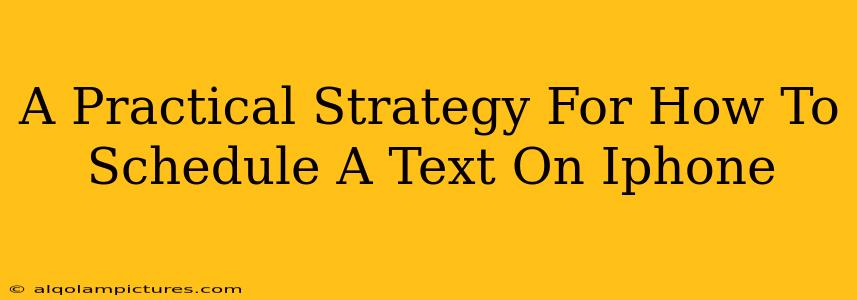Scheduling a text message on your iPhone can be incredibly useful for birthdays, reminders, or simply sending a message at a more convenient time. While the native Messages app doesn't offer built-in scheduling, several strategies can help you achieve this. This guide provides a practical, step-by-step approach to help you master this handy iPhone feature.
Why Schedule Texts?
Before diving into the methods, let's understand why scheduling texts is beneficial:
- Never miss a birthday or anniversary greeting again: Ensure your loved ones receive your well wishes at the precise moment.
- Send reminders without the hassle: Schedule reminders for appointments, tasks, or medication.
- Efficient time management: Compose messages in advance and let them send automatically at the optimal time, freeing up your time.
- Avoid late-night or early-morning disturbances: Schedule messages to arrive during the recipient's waking hours.
Methods to Schedule Texts on Your iPhone
Unfortunately, there isn't a direct "schedule text" button in the iPhone's built-in Messages app. However, here are some effective workarounds:
Method 1: Using the Shortcuts App (Most Recommended)
Apple's Shortcuts app is a powerful tool for automation, and it's perfect for scheduling text messages. While it requires some initial setup, it offers a flexible and reliable solution. Here's a basic guide:
- Open the Shortcuts app: Locate it on your home screen.
- Create a new shortcut: Tap the "+" button.
- Add actions: You'll need a few actions:
- Get Text: This retrieves the message you'll schedule.
- Ask for Input: To input recipient's phone number and message.
- Set a Timer: To set your desired time.
- Send Message: This sends your text using the Messages app.
- Customize the shortcut: Adjust the actions to match your needs—customize text prompts, set specific dates and times.
- Run the shortcut and test: Send a test message to ensure everything is configured correctly.
Important Note: You might need to grant the Shortcuts app access to your Contacts and Messages for this to work correctly.
Method 2: Utilizing Third-Party Apps
Several apps in the App Store specialize in scheduling messages. These apps typically offer more features than the Shortcuts method but might require a subscription or in-app purchases.
Things to Consider When Choosing a Third-Party App:
- App reviews and ratings: Look for apps with high ratings and positive user feedback.
- Permissions required: Review the app's permissions carefully. Avoid apps that request excessive access to your device.
- Privacy policy: Ensure the app has a clear privacy policy that protects your data.
Method 3: Using Email or Other Messaging Services (For Less Urgent Messages)
For less time-sensitive messages, consider using email or alternative messaging apps like WhatsApp with scheduling capabilities. These options are simple, but they might not always deliver the same conversational feel as a text message.
Optimizing Your Scheduled Text Strategy
- Proofread carefully: Ensure your message is accurate before scheduling it.
- Choose the right method: The Shortcuts app offers the most control and avoids relying on third-party apps, but third-party apps might offer more features.
- Test your setup: Send a test message to confirm everything works correctly before relying on scheduled messages for important occasions.
- Back up your phone regularly: If you're using a third-party app, ensure your data is regularly backed up in case the app encounters problems.
Conclusion: Mastering Scheduled Texts on iPhone
Scheduling text messages on your iPhone might require a bit of initial setup, but the long-term benefits of improved time management and reliable message delivery make it worthwhile. By exploring the methods outlined above and considering the optimization tips, you'll be well-equipped to schedule your messages effectively. Remember to carefully evaluate your options and choose the approach that best fits your needs and comfort level.

